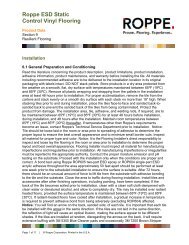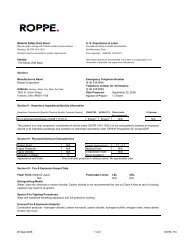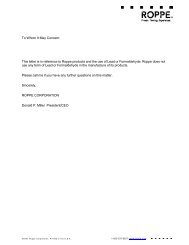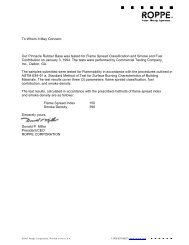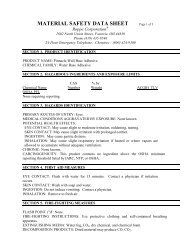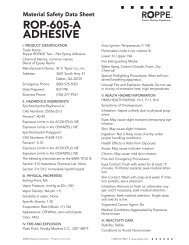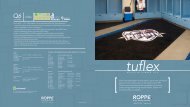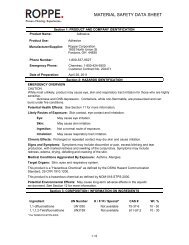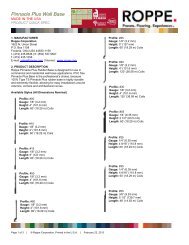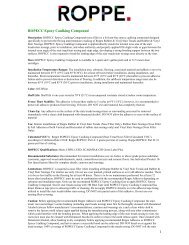435 Adhesive - Roppe Corporation
435 Adhesive - Roppe Corporation
435 Adhesive - Roppe Corporation
Create successful ePaper yourself
Turn your PDF publications into a flip-book with our unique Google optimized e-Paper software.
Material Safety Data Sheet<br />
Material Name: ROP <strong>435</strong> - Part A<br />
ID: SAH00013<br />
* * * Section 1 - Chemical Product and Company Identification * * *<br />
Material Name: ROP <strong>435</strong> - Part A<br />
Product Use<br />
<strong>Adhesive</strong><br />
Manufacturer Information<br />
<strong>Roppe</strong> <strong>Corporation</strong><br />
1602 North Union St<br />
Fostoria, OH 44830-1158<br />
Phone: 1-800-537-9527<br />
Phone: 1-419-<strong>435</strong>-8546<br />
Fax: 1-419-<strong>435</strong>-1056<br />
IN THE EVENT OF A CHEMICAL EMERGENCY INVOLVING A SPILL, LEAK, FIRE, EXPLOSION, EXPOSURE<br />
OR ACCIDENT, CONTACT THE FOLLOWING NUMBERS:<br />
Emergency 24 hour numbers:<br />
(USA) CHEMTREC 1-800-424-9300<br />
(Canada) CANUTEC 1-631-996-6666<br />
* * * Section 2 - Hazards Identification * * *<br />
Emergency Overview<br />
This product is considered hazardous under 29 CFR 1910.1200 (Hazard Communication). This product is<br />
irritating to the eyes, respiratory system and skin. May cause sensitization by skin contact. This product may be<br />
harmful or fatal if swallowed.<br />
Hazard Statements<br />
CAUTION! IRRITANT. ALLERGEN. Irritating to eyes, respiratory system and skin. May cause sensitization by<br />
skin contact. May be harmful or fatal if swallowed. Wear suitable gloves and eye/face protection. Keep out of the<br />
reach of children.<br />
Potential Health Effects: Eyes<br />
This product is irritating to the eyes.<br />
Potential Health Effects: Skin<br />
This product is irritating to the skin. Prolonged contact with this product may cause allergic skin sensitization<br />
reactions.<br />
Potential Health Effects: Ingestion<br />
This product may be harmful or fatal if swallowed. Ingestion of this product may cause nausea, vomiting and<br />
diarrhea.<br />
Potential Health Effects: Inhalation<br />
This product is irritating to the respiratory system.<br />
Medical Conditions Aggravated by Exposure<br />
Hypersensitivity to product, allergies, and skin or respiratory disorders<br />
Potential Environmental Effects<br />
None identified.<br />
HMIS Ratings: Health: 2 Fire: 0 Reactivity: 1 Pers. Prot.: Safety glasses, gloves<br />
Hazard Scale: 0 = Minimal 1 = Slight 2 = Moderate 3 = Serious 4 = Severe * = Chronic hazard<br />
* * * Section 3 - Composition / Information on Ingredients * * *<br />
CAS # Component Percent<br />
1317-65-3 Limestone 15-40<br />
25085-99-8 Epoxy Resin 15-40<br />
Proprietary Alkyl phenol blocked polyisocyanate 10-30<br />
____________________________________________________________<br />
Page 1 of 6 Issue Date: 29 April 2009 Revision: 1.0002 Print Date: 4/29/2009
Material Safety Data Sheet<br />
Material Name: ROP <strong>435</strong> - Part A<br />
ID: SAH00013<br />
2210-79-9 o-Cresylglycidyl Ether 5-10<br />
57-55-6 1,2-Propylene glycol 1-5<br />
27138-31-4 Propanol, oxybis-, dibenzoate 1-5<br />
67762-90-7 Dimethyl silicone polymer with silica 1-5<br />
Proprietary Alkyl Quaternary Ammonium Clay 0.5-1.5<br />
* * * Section 4 - First Aid Measures * * *<br />
First Aid: Eyes<br />
In case of contact, immediately flush eyes with large amounts of water, continuing to flush for 15 minutes. If<br />
irritation persists get medical attention.<br />
First Aid: Skin<br />
For skin contact, flush with large amounts of water. If irritation persists, get medical attention.<br />
First Aid: Ingestion<br />
For ingestion, flush out mouth with water. If ingestion of a large amount does occur, seek medical attention. Do<br />
not induce vomiting.<br />
First Aid: Inhalation<br />
If inhaled, immediately remove the affected person to fresh air. If the affected person is not breathing, apply<br />
artificial respiration. If symptoms persist, get medical attention.<br />
First Aid: Notes to Physician<br />
Provide general supportive measures and treat symptomatically.<br />
* * * Section 5 - Fire Fighting Measures * * *<br />
General Fire Hazards<br />
See Section 9 for Flammability Properties.<br />
This product is an aqueous mixture which will not burn. If evaporated to dryness, the solid residue may pose a<br />
moderate fire hazard.<br />
Hazardous Combustion Products<br />
Irritating and toxic gases or fumes may be released during a fire. Upon decomposition, this product emits carbon<br />
monoxide, carbon dioxide and/or low molecular weight hydrocarbons.<br />
Extinguishing Media<br />
Dry chemical (preferred), foam, water.<br />
Fire Fighting Equipment/Instructions<br />
Firefighters should wear full protective gear.<br />
NFPA Ratings: Health: 2 Fire: 0 Reactivity: 1<br />
Hazard Scale: 0 = Minimal 1 = Slight 2 = Moderate 3 = Serious 4 = Severe<br />
* * * Section 6 - Accidental Release Measures * * *<br />
Personal Precautions<br />
Wear appropriate protective equipment and clothing during clean-up.<br />
Containment Procedures<br />
Dike the spilled material, where this is possible. Absorb with inert absorbent such as dry clay, sand or<br />
diatomaceous earth, commercial sorbents, or recover using pumps. Scoop up used absorbent into drums or other<br />
appropriate container.<br />
Environmental Precautions<br />
Dispose of waste material according to Local, State, Federal, and Provincial Environmental Regulations.<br />
Clean-Up Procedures<br />
Attempt to reclaim the free product, if this is possible. Shovel the material into waste container. Thoroughly wash<br />
the area with water after a spill or leak clean-up. Keep out of the reach of children.<br />
Evacuation Procedures<br />
None identified.<br />
Special Procedures<br />
Regulations vary. Consult local authorities before disposal.<br />
____________________________________________________________<br />
Page 2 of 6 Issue Date: 29 April 2009 Revision: 1.0002 Print Date: 4/29/2009
Material Safety Data Sheet<br />
Material Name: ROP <strong>435</strong> - Part A<br />
ID: SAH00013<br />
* * * Section 7 - Handling and Storage * * *<br />
Handling Procedures<br />
Avoid getting this material into contact with your skin and eyes. Avoid breathing vapors or mists of this product.<br />
Wash hands after handling and before eating. Keep out of the reach of children.<br />
Storage Procedures<br />
Store in a cool, dry, well-ventilated area. Store at ambient temperature and atmospheric pressure. Keep out of<br />
sun.<br />
* * * Section 8 - Exposure Controls / Personal Protection * * *<br />
A: Component Exposure Limits<br />
Limestone (1317-65-3)<br />
OSHA (Final):<br />
NIOSH:<br />
Alberta:<br />
British Columbia:<br />
New Brunswick:<br />
NW Territories:<br />
Nunavut:<br />
Quebec:<br />
Saskatchewan:<br />
Yukon:<br />
15 mg/m3 TWA (total dust); 5 mg/m3 TWA (respirable fraction)<br />
10 mg/m3 TWA (total dust); 5 mg/m3 TWA (respirable dust)<br />
10 mg/m3 TWA<br />
10 mg/m3 TWA (total dust); 3 mg/m3 TWA (respirable fraction)<br />
20 mg/m3 STEL (total dust)<br />
10 mg/m3 TWA (particulate matter containing no asbestos and < 1% crystalline silica)<br />
5 mg/m3 TWA (respirable mass); 10 mg/m3 TWA (total mass)<br />
5 mg/m3 TWA (respirable mass); 10 mg/m3 TWA (total mass)<br />
10 mg/m3 TWAEV (total dust, containing no asbestos and less than 1% crystalline silica)<br />
10 mg/m3 TWA<br />
20 mg/m3 STEL<br />
30 mppcf TWA; 10 mg/m3 TWA<br />
20 mg/m3 STEL<br />
1,2-Propylene glycol (57-55-6)<br />
Ontario:<br />
50 ppm TWAEV (total aerosol and vapour); 155 mg/m3 TWAEV (total aerosol and vapour); 10 mg/m3<br />
TWAEV (aerosol only, for assessing the visibility in a work environment)<br />
Engineering Controls<br />
Provide adequate local exhaust ventilation to maintain worker exposure below exposure limits. Local exhaust is<br />
suggested for use, where possible, in enclosed or confined spaces.<br />
PERSONAL PROTECTIVE EQUIPMENT<br />
Personal Protective Equipment: Eyes/Face<br />
Wear safety glasses with side shields.<br />
Personal Protective Equipment: Skin<br />
The use of nitrile-latex gloves is recommended.<br />
Personal Protective Equipment: Respiratory<br />
Not normally needed. If airborne concentrations are above the applicable exposure limits, use NIOSH approved<br />
respiratory protection.<br />
Personal Protective Equipment: General<br />
Launder contaminated clothing before reuse. Use good industrial hygiene practices in handling this material.<br />
* * * Section 9 - Physical & Chemical Properties * * *<br />
____________________________________________________________<br />
Page 3 of 6 Issue Date: 29 April 2009 Revision: 1.0002 Print Date: 4/29/2009
Material Safety Data Sheet<br />
Material Name: ROP <strong>435</strong> - Part A<br />
ID: SAH00013<br />
Appearance: Paste Odor: Epoxy Odor<br />
Physical State: N/A pH: N/A<br />
Vapor Pressure: N/A Vapor Density: N/A<br />
Boiling Point: N/A Melting Point: N/A<br />
Solubility (H2O): N/A Specific Gravity: 1.37<br />
Evaporation Rate: N/A VOC: N/A<br />
Octanol/H2O Coeff.: N/A Flash Point: N/A<br />
Flash Point Method: N/A Upper Flammability Limit N/A<br />
(UFL):<br />
Lower Flammability Limit N/A Burning Rate: N/A<br />
(LFL):<br />
Auto Ignition: N/A<br />
Physical Properties: Additional Information<br />
The data provided in this section is to be used for product safety handling purposes. Please refer to Product Data<br />
Sheets, Certificates of Conformity or Certificates of Analysis for chemical and physical data for determinations of<br />
quality and for formulation purposes.<br />
* * * Section 10 - Chemical Stability & Reactivity Information * * *<br />
Chemical Stability<br />
Stable under normal conditions.<br />
Chemical Stability: Conditions to Avoid<br />
Do not freeze.<br />
Incompatibility<br />
This product may react with strong acids, bases and oxidizing agents.<br />
Hazardous Decomposition<br />
Irritating and/or toxic fumes and gases may be emitted upon the product's decomposition. Upon decomposition,<br />
this product may emit fumes of carbon monoxide, carbon dioxide, oxides of nitrogen, and other organic<br />
compounds.<br />
Possibility of Hazardous Reactions<br />
Will not occur.<br />
* * * Section 11 - Toxicological Information * * *<br />
Acute Dose Effects<br />
A: General Product Information<br />
No information available for the product.<br />
B: Component Analysis - LD50/LC50<br />
o-Cresylglycidyl Ether (2210-79-9)<br />
Inhalation LC50 Rat: 6090 mg/m3/4H; Oral LD50 Rat:4 g/kg<br />
1,2-Propylene glycol (57-55-6)<br />
Oral LD50 Rat: 20000 mg/kg; Dermal LD50 Rabbit:20800 mg/kg<br />
Carcinogenicity<br />
A: General Product Information<br />
No information available for the product.<br />
B: Component Carcinogenicity<br />
None of this product's components are listed by ACGIH, IARC, OSHA, NIOSH, or NTP.<br />
Sensitization<br />
No information available for the product.<br />
____________________________________________________________<br />
Page 4 of 6 Issue Date: 29 April 2009 Revision: 1.0002 Print Date: 4/29/2009
Material Safety Data Sheet<br />
Material Name: ROP <strong>435</strong> - Part A<br />
ID: SAH00013<br />
* * * Section 12 - Ecological Information * * *<br />
Ecotoxicity<br />
A: General Product Information<br />
No information available for the product.<br />
B: Component Analysis - Ecotoxicity - Aquatic Toxicity<br />
1,2-Propylene glycol (57-55-6)<br />
Test & Species<br />
Conditions<br />
96 Hr LC50 Oncorhynchus mykiss 51600 mg/L [static]<br />
96 Hr LC50 Oncorhynchus mykiss 41-47 ml/L [static]<br />
96 Hr LC50 Pimephales promelas 51400 mg/L [static]<br />
96 Hr LC50 Pimephales promelas 710 mg/L<br />
96 Hr EC50 Selenastrum<br />
capricornutum<br />
19000 mg/L<br />
* * * Section 13 - Disposal Considerations * * *<br />
US EPA Waste Number & Descriptions<br />
A: General Product Information<br />
No additional information available.<br />
B: Component Waste Numbers<br />
No EPA Waste Numbers are applicable for this product's components.<br />
Disposal Instructions<br />
Waste must be handled in accordance with all federal, state, provincial, and local regulations. Consult authorities<br />
before disposal.<br />
See Section 7 for Handling Procedures. See Section 8 for Personal Protective Equipment recommendations.<br />
* * * Section 14 - Transportation Information * * *<br />
International Transportation Regulations<br />
Not regulated as dangerous goods.<br />
* * * Section 15 - Regulatory Information * * *<br />
US Federal Regulations<br />
A: General Product Information<br />
All components are on the U.S. EPA TSCA Inventory List. All components of this product are included, or are<br />
exempt from inclusion, in the Canadian Domestic Substance List unless otherwise noted.<br />
B: Component Analysis<br />
None of this products components are listed under SARA Section 302 (40 CFR 355 Appendix A), SARA Section<br />
313 (40 CFR 372.65), or CERCLA (40 CFR 302.4).<br />
State Regulations<br />
A: General Product Information<br />
Other state regulations may apply. Check individual state requirements.<br />
B: Component Analysis - State<br />
The following components appear on one or more of the following state hazardous substances lists:<br />
Component CAS CA MA MN NJ PA RI<br />
Limestone 1317-65-3 No Yes Yes Yes Yes Yes<br />
1,2-Propylene glycol 57-55-6 No No Yes Yes Yes Yes<br />
____________________________________________________________<br />
Page 5 of 6 Issue Date: 29 April 2009 Revision: 1.0002 Print Date: 4/29/2009
Material Safety Data Sheet<br />
Material Name: ROP <strong>435</strong> - Part A<br />
ID: SAH00013<br />
Canadian WHMIS Information<br />
A: General Product Information<br />
B: Component Analysis - WHMIS IDL<br />
The following components are identified under the Canadian Hazardous Products Act Ingredient Disclosure List:<br />
Component CAS # Minimum Concentration<br />
1,2-Propylene glycol 57-55-6 1 %<br />
Additional Regulatory Information<br />
A: General Product Information<br />
Supplier(s) of proprietary component(s) state that these components are contained on the TSCA inventory.<br />
B: Component Analysis - Inventory<br />
Component CAS # TSCA CAN EEC<br />
Limestone 1317-65-3 Yes NDSL EINECS<br />
Epoxy Resin 25085-99-8 Yes DSL No<br />
o-Cresylglycidyl Ether 2210-79-9 Yes DSL EINECS<br />
1,2-Propylene glycol 57-55-6 Yes DSL EINECS<br />
Propanol, oxybis-, dibenzoate 27138-31-4 Yes DSL EINECS<br />
Dimethyl silicone polymer with silica 67762-90-7 Yes DSL No<br />
* * * Section 16 - Other Information * * *<br />
Other Information<br />
Reasonable care has been taken in the preparation of this information, but the manufacturer makes no warranty of merchantability or any<br />
other warranty, expressed or implied, with respect to this information. The manufacturer makes no representations and assumes no liability for<br />
any direct, incidental or consequential damages resulting from its use.<br />
Key/Legend<br />
NA = Not available or Not Applicable. ACGIH = American Conference of Governmental Industrial Hygienists. NFPA = National Fire Protection<br />
Association. EPA = Environmental Protection Agency; TSCA = Toxic Substance Control Act; ACGIH = American Conference of<br />
Governmental Industrial Hygienists; IARC = International Agency for Research on Cancer; NIOSH = National Institute for Occupational<br />
Safety and Health; NTP = National Toxicology Program; OSHA = Occupational Safety and Health Administration., NJTSR = New Jersey<br />
Trade Secret Registry.<br />
End of Sheet SAH00013<br />
____________________________________________________________<br />
Page 6 of 6 Issue Date: 29 April 2009 Revision: 1.0002 Print Date: 4/29/2009
Material Safety Data Sheet<br />
Material Name: ROP <strong>435</strong> - Part B<br />
ID: SAH00014<br />
* * * Section 1 - Chemical Product and Company Identification * * *<br />
Material Name: ROP <strong>435</strong> - Part B<br />
Product Use<br />
<strong>Adhesive</strong><br />
Manufacturer Information<br />
<strong>Roppe</strong> <strong>Corporation</strong><br />
1602 North Union St<br />
Fostoria, OH 44830-1158<br />
Phone: 1-800-537-9527<br />
Phone: 1-419-<strong>435</strong>-8546<br />
Fax: 1-419-<strong>435</strong>-1056<br />
IN THE EVENT OF A CHEMICAL EMERGENCY INVOLVING A SPILL, LEAK, FIRE, EXPLOSION, EXPOSURE<br />
OR ACCIDENT, CONTACT THE FOLLOWING NUMBERS:<br />
Emergency 24 hour numbers:<br />
(USA) CHEMTREC 1-800-424-9300<br />
(Canada) CANUTEC 1-631-996-6666<br />
* * * Section 2 - Hazards Identification * * *<br />
Emergency Overview<br />
This product is considered hazardous under 29 CFR 1910.1200 (Hazard Communication). Causes burns to the<br />
skin and eyes. Risk of serious damage to eyes. Irritating to respiratory system.<br />
Hazard Statements<br />
DANGER! CORROSIVE. Causes burns to the skin and eyes. Irritating to respiratory system. Wear suitable<br />
gloves, eye/face protection, and respiratory protection. Keep out of the reach of children.<br />
Potential Health Effects: Eyes<br />
This product is severely irritating to the eyes and may cause eye burns.<br />
Potential Health Effects: Skin<br />
This product is severely irritating to the skin and may cause burns. Prolonged contact with this product may cause<br />
allergic skin sensitization reactions.<br />
Potential Health Effects: Ingestion<br />
Ingestion of this product may cause nausea, vomiting and diarrhea.<br />
Potential Health Effects: Inhalation<br />
This product is irritating to the respiratory system. This product may cause sensitization by inhalation.<br />
Medical Conditions Aggravated by Exposure<br />
Hypersensitivity to product, allergies, and skin or respiratory disorders<br />
Potential Environmental Effects<br />
None identified.<br />
HMIS Ratings: Health: 2 Fire: 0 Reactivity: 1 Pers. Prot.: Safety glasses, gloves, synthetic apron, vapor respirator if<br />
airborne concentrations exceed exposure limits<br />
Hazard Scale: 0 = Minimal 1 = Slight 2 = Moderate 3 = Serious 4 = Severe * = Chronic hazard<br />
* * * Section 3 - Composition / Information on Ingredients * * *<br />
CAS # Component Percent<br />
52338-87-1 Urea, N,N'-bis[3-(dimethylamino)propyl]- 30-60<br />
111-40-0 Diethylene triamine 15-40<br />
68610-56-0 Epoxy Resin 10-30<br />
80-05-7 Bisphenol A 10-30<br />
____________________________________________________________<br />
Page 1 of 7 Issue Date: 17 April 2009 Revision: 1.0000 Print Date: 4/17/2009
Material Safety Data Sheet<br />
Material Name: ROP <strong>435</strong> - Part B<br />
ID: SAH00014<br />
* * * Section 4 - First Aid Measures * * *<br />
First Aid: Eyes<br />
In case of contact, immediately flush eyes with large amounts of water, continuing to flush for 15 minutes. If<br />
irritation persists get medical attention.<br />
First Aid: Skin<br />
For skin contact, wash immediately with soap and water. If irritation persists, get medical attention.<br />
First Aid: Ingestion<br />
For ingestion, flush out mouth with water. Get medical attention or advice. Do not induce vomiting.<br />
First Aid: Inhalation<br />
If inhaled, immediately remove the affected person to fresh air. If the affected person is not breathing, apply<br />
artificial respiration. If symptoms persist, get medical attention.<br />
First Aid: Notes to Physician<br />
Provide general supportive measures and treat symptomatically.<br />
* * * Section 5 - Fire Fighting Measures * * *<br />
General Fire Hazards<br />
See Section 9 for Flammability Properties.<br />
This product is an aqueous mixture which will not burn. If evaporated to dryness, the solid residue may pose a<br />
moderate fire hazard.<br />
Hazardous Combustion Products<br />
Irritating and toxic gases or fumes may be released during a fire. Upon decomposition, this product emits carbon<br />
monoxide, carbon dioxide and/or low molecular weight hydrocarbons.<br />
Extinguishing Media<br />
Dry chemical (preferred), foam, water.<br />
Fire Fighting Equipment/Instructions<br />
Firefighters should wear full protective clothing including self contained breathing apparatus.<br />
NFPA Ratings: Health: 3 Fire: 0 Reactivity: 1<br />
Hazard Scale: 0 = Minimal 1 = Slight 2 = Moderate 3 = Serious 4 = Severe<br />
* * * Section 6 - Accidental Release Measures * * *<br />
Personal Precautions<br />
Wear appropriate protective equipment and clothing during clean-up.<br />
Containment Procedures<br />
Dike the spilled material, where this is possible. Absorb with inert absorbent such as dry clay, sand or<br />
diatomaceous earth, commercial sorbents, or recover using pumps. Scoop up used absorbent into drums or other<br />
appropriate container.<br />
Environmental Precautions<br />
Dispose of waste material according to Local, State, Federal, and Provincial Environmental Regulations.<br />
Clean-Up Procedures<br />
Attempt to reclaim the free product, if this is possible. Shovel the material into waste container. Thoroughly wash<br />
the area with water after a spill or leak clean-up. Keep out of the reach of children.<br />
Evacuation Procedures<br />
None identified.<br />
Special Procedures<br />
Regulations vary. Consult local authorities before disposal.<br />
* * * Section 7 - Handling and Storage * * *<br />
Handling Procedures<br />
Avoid getting this material into contact with your skin and eyes. Avoid breathing vapors or mists of this product.<br />
Wash hands after handling and before eating. Keep out of the reach of children.<br />
____________________________________________________________<br />
Page 2 of 7 Issue Date: 17 April 2009 Revision: 1.0000 Print Date: 4/17/2009
Material Safety Data Sheet<br />
Material Name: ROP <strong>435</strong> - Part B<br />
ID: SAH00014<br />
Storage Procedures<br />
Store in a cool, dry, well-ventilated area. Store at ambient temperature and atmospheric pressure. Store away<br />
from strong oxidizers.<br />
* * * Section 8 - Exposure Controls / Personal Protection * * *<br />
A: Component Exposure Limits<br />
Diethylene triamine (111-40-0)<br />
ACGIH: 1 ppm TWA<br />
Skin - potential significant contribution to overall exposure by the cutaneous route<br />
NIOSH: 1 ppm TWA; 4 mg/m3 TWA<br />
Potential for dermal absorption<br />
Alberta: 1 ppm TWA; 4.2 mg/m3 TWA<br />
Substance may be readily absorbed through intact skin<br />
British Columbia: Sensitizer<br />
1 ppm TWA<br />
Skin notation<br />
Manitoba:<br />
New Brunswick:<br />
NW Territories:<br />
Nova Scotia:<br />
Nunavut:<br />
Ontario:<br />
Quebec:<br />
Saskatchewan:<br />
Yukon:<br />
1 ppm TWA<br />
1 ppm TWA; 4.2 mg/m3 TWA<br />
Skin - potential for cutaneous absorption<br />
1 ppm TWA; 4 mg/m3 TWA<br />
3 ppm STEL; 13 mg/m3 STEL<br />
Skin notation<br />
1 ppm TWA<br />
Skin - potential significant contribution to overall exposure by the cutaneous route<br />
1 ppm TWA; 4 mg/m3 TWA<br />
3 ppm STEL; 13 mg/m3 STEL<br />
Skin notation<br />
1 ppm TWAEV; 4 mg/m3 TWAEV<br />
Absorption through skin, eyes, or mucous membranes<br />
1 ppm TWAEV; 4.2 mg/m3 TWAEV<br />
Skin designation<br />
1 ppm TWA<br />
2 ppm STEL<br />
1 ppm TWA; 4 mg/m3 TWA<br />
1 ppm STEL; 4 mg/m3 STEL<br />
Skin notation<br />
Bisphenol A (80-05-7)<br />
Yukon: 0.5 ppm Ceiling; 2.8 ppm Ceiling<br />
Engineering Controls<br />
Use general ventilation.<br />
PERSONAL PROTECTIVE EQUIPMENT<br />
Personal Protective Equipment: Eyes/Face<br />
Wear safety glasses with side shields.<br />
Personal Protective Equipment: Skin<br />
The use of nitrile-latex gloves is recommended.<br />
Personal Protective Equipment: Respiratory<br />
If airborne concentrations are above the applicable exposure limits, use NIOSH approved respiratory protection.<br />
Personal Protective Equipment: General<br />
Launder contaminated clothing before reuse. Use good industrial hygiene practices in handling this material.<br />
____________________________________________________________<br />
Page 3 of 7 Issue Date: 17 April 2009 Revision: 1.0000 Print Date: 4/17/2009
Material Safety Data Sheet<br />
Material Name: ROP <strong>435</strong> - Part B<br />
ID: SAH00014<br />
* * * Section 9 - Physical & Chemical Properties * * *<br />
Appearance: Liquid Odor: Amine odor<br />
Physical State: Liquid pH: N/A<br />
Vapor Pressure: N/A Vapor Density: N/A<br />
Boiling Point: N/A Melting Point: N/A<br />
Solubility (H2O): Negligible Specific Gravity: 0.98<br />
Evaporation Rate: N/A VOC: N/A<br />
Octanol/H2O Coeff.: N/A Flash Point: N/A<br />
Flash Point Method: N/A Upper Flammability Limit N/A<br />
(UFL):<br />
Lower Flammability Limit N/A Burning Rate: N/A<br />
(LFL):<br />
Auto Ignition: N/A<br />
Physical Properties: Additional Information<br />
The data provided in this section is to be used for product safety handling purposes. Please refer to Product Data<br />
Sheets, Certificates of Conformity or Certificates of Analysis for chemical and physical data for determinations of<br />
quality and for formulation purposes.<br />
* * * Section 10 - Chemical Stability & Reactivity Information * * *<br />
Chemical Stability<br />
Stable under normal conditions.<br />
Chemical Stability: Conditions to Avoid<br />
Do not freeze.<br />
Incompatibility<br />
This product may react with strong acids, bases and oxidizing agents.<br />
Hazardous Decomposition<br />
Irritating and/or toxic fumes and gases may be emitted upon the product's decomposition. Upon decomposition,<br />
this product may emit fumes of carbon monoxide, carbon dioxide, oxides of nitrogen, and other organic<br />
compounds.<br />
Possibility of Hazardous Reactions<br />
Will not occur.<br />
* * * Section 11 - Toxicological Information * * *<br />
Acute Dose Effects<br />
A: General Product Information<br />
No information available for the product.<br />
B: Component Analysis - LD50/LC50<br />
Diethylene triamine (111-40-0)<br />
Oral LD50 Rat: 819 mg/kg; Dermal LD50 Rabbit:672 mg/kg<br />
Bisphenol A (80-05-7)<br />
Oral LD50 Rat: 3200 mg/kg; Dermal LD50 Rabbit:3000 mg/kg<br />
Carcinogenicity<br />
A: General Product Information<br />
No information available for the product.<br />
B: Component Carcinogenicity<br />
None of this product's components are listed by ACGIH, IARC, OSHA, NIOSH, or NTP.<br />
Sensitization<br />
No information available for the product.<br />
____________________________________________________________<br />
Page 4 of 7 Issue Date: 17 April 2009 Revision: 1.0000 Print Date: 4/17/2009
Material Safety Data Sheet<br />
Material Name: ROP <strong>435</strong> - Part B<br />
ID: SAH00014<br />
* * * Section 12 - Ecological Information * * *<br />
Ecotoxicity<br />
A: General Product Information<br />
No information available for the product.<br />
B: Component Analysis - Ecotoxicity - Aquatic Toxicity<br />
Diethylene triamine (111-40-0)<br />
Test & Species<br />
Conditions<br />
96 Hr LC50 Leuciscus idus 430 mg/L [semi-static]<br />
96 Hr LC50 Poecilia reticulata 248 mg/L [static]<br />
96 Hr LC50 Poecilia reticulata 1014 mg/L [semi-static]<br />
72 Hr EC50 Selenastrum<br />
1164 mg/L<br />
capricornutum<br />
96 Hr EC50 Selenastrum<br />
345.6 mg/L<br />
capricornutum<br />
96 Hr EC50 Scenedesmus<br />
subspicatus<br />
592 mg/L<br />
Bisphenol A (80-05-7)<br />
Test & Species<br />
Conditions<br />
96 Hr LC50 Pimephales promelas 3.6-5.4 mg/L [flow-through]<br />
96 Hr LC50 Pimephales promelas 4.0-5.5 mg/L [static]<br />
96 Hr LC50 Oncorhynchus mykiss 4 mg/L<br />
96 Hr LC50 Brachydanio rerio 9.9 mg/L [static]<br />
96 Hr EC50 Selenastrum<br />
2.5 mg/L<br />
capricornutum<br />
48 Hr EC50 water flea 10 mg/L<br />
48 Hr EC50 Daphnia magna 3.9 mg/L<br />
* * * Section 13 - Disposal Considerations * * *<br />
US EPA Waste Number & Descriptions<br />
A: General Product Information<br />
No additional information available.<br />
B: Component Waste Numbers<br />
No EPA Waste Numbers are applicable for this product's components.<br />
Disposal Instructions<br />
Waste must be handled in accordance with all federal, state, provincial, and local regulations. Consult authorities<br />
before disposal.<br />
See Section 7 for Handling Procedures. See Section 8 for Personal Protective Equipment recommendations.<br />
* * * Section 14 - Transportation Information * * *<br />
US DOT Information<br />
Shipping Name: Amines, liquid, corrosive, n.o.s. ( Diethylene triamine , Modified Aliphatic Amine Adduct)<br />
UN/NA #: UN2735 Hazard Class: 8 Packing Group: III<br />
IATA Information<br />
Shipping Name: Amines, liquid, corrosive, n.o.s. ( Diethylene triamine , Modified Aliphatic Amine Adduct)<br />
UN #: UN2735 Hazard Class: 8 Packing Group: III<br />
TDG Information<br />
Shipping Name: Amines, liquid, corrosive, n.o.s. ( Diethylene triamine , Modified Aliphatic Amine Adduct)<br />
UN/NA #: UN2735 Hazard Class: 8 Packing Group: III<br />
____________________________________________________________<br />
Page 5 of 7 Issue Date: 17 April 2009 Revision: 1.0000 Print Date: 4/17/2009
Material Safety Data Sheet<br />
Material Name: ROP <strong>435</strong> - Part B<br />
ID: SAH00014<br />
* * * Section 15 - Regulatory Information * * *<br />
US Federal Regulations<br />
A: General Product Information<br />
All components are on the U.S. EPA TSCA Inventory List. All components of this product are included, or are<br />
exempt from inclusion, in the Canadian Domestic Substance List unless otherwise noted.<br />
B: Component Analysis<br />
This material contains one or more of the following chemicals required to be identified under SARA Section 302<br />
(40 CFR 355 Appendix A), SARA Section 313 (40 CFR 372.65) and/or CERCLA (40 CFR 302.4).<br />
Bisphenol A (80-05-7)<br />
SARA 313: 1.0 % de minimis concentration<br />
State Regulations<br />
A: General Product Information<br />
Other state regulations may apply. Check individual state requirements.<br />
B: Component Analysis - State<br />
The following components appear on one or more of the following state hazardous substances lists:<br />
Component CAS CA MA MN NJ PA RI<br />
Diethylene triamine 111-40-0 Yes Yes Yes Yes Yes Yes<br />
Bisphenol A 80-05-7 No Yes No Yes Yes No<br />
Canadian WHMIS Information<br />
A: General Product Information<br />
B: Component Analysis - WHMIS IDL<br />
The following components are identified under the Canadian Hazardous Products Act Ingredient Disclosure List:<br />
Component CAS # Minimum Concentration<br />
Diethylene triamine 111-40-0 0.1 %<br />
Bisphenol A 80-05-7 1 %<br />
Additional Regulatory Information<br />
A: General Product Information<br />
Supplier(s) of proprietary component(s) state that these components are contained on the TSCA inventory.<br />
B: Component Analysis - Inventory<br />
Component CAS # TSCA CAN EEC<br />
Urea, N,N'-bis[3-(dimethylamino)propyl]- 52338-87-1 Yes DSL EINECS<br />
Diethylene triamine 111-40-0 Yes DSL EINECS<br />
Epoxy Resin 68610-56-0 Yes DSL No<br />
Bisphenol A 80-05-7 Yes DSL EINECS<br />
Reference Version (internal)<br />
Q1-2479-05<br />
* * * Section 16 - Other Information * * *<br />
____________________________________________________________<br />
Page 6 of 7 Issue Date: 17 April 2009 Revision: 1.0000 Print Date: 4/17/2009
Material Safety Data Sheet<br />
Material Name: ROP <strong>435</strong> - Part B<br />
ID: SAH00014<br />
Other Information<br />
Reasonable care has been taken in the preparation of this information, but the manufacturer makes no warranty of merchantability or any<br />
other warranty, expressed or implied, with respect to this information. The manufacturer makes no representations and assumes no liability for<br />
any direct, incidental or consequential damages resulting from its use.<br />
Key/Legend<br />
NA = Not available or Not Applicable. ACGIH = American Conference of Governmental Industrial Hygienists. NFPA = National Fire Protection<br />
Association. EPA = Environmental Protection Agency; TSCA = Toxic Substance Control Act; ACGIH = American Conference of<br />
Governmental Industrial Hygienists; IARC = International Agency for Research on Cancer; NIOSH = National Institute for Occupational<br />
Safety and Health; NTP = National Toxicology Program; OSHA = Occupational Safety and Health Administration., NJTSR = New Jersey<br />
Trade Secret Registry.<br />
End of Sheet SAH00014<br />
____________________________________________________________<br />
Page 7 of 7 Issue Date: 17 April 2009 Revision: 1.0000 Print Date: 4/17/2009



